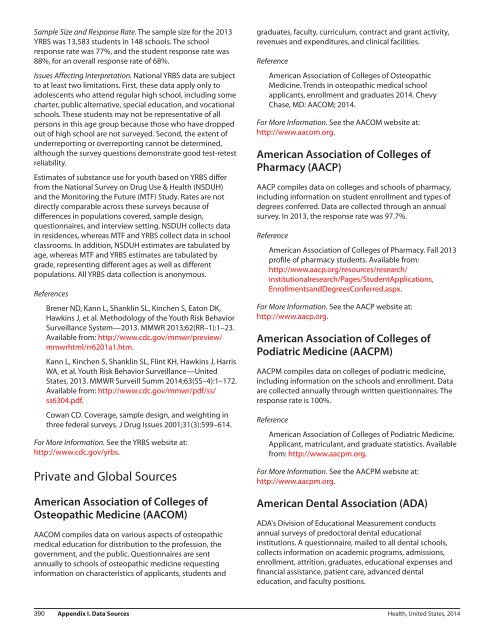hus14
hus14
hus14
Create successful ePaper yourself
Turn your PDF publications into a flip-book with our unique Google optimized e-Paper software.
Sample Size and Response Rate. The sample size for the 2013<br />
YRBS was 13,583 students in 148 schools. The school<br />
response rate was 77%, and the student response rate was<br />
88%, for an overall response rate of 68%.<br />
Issues Affecting Interpretation. National YRBS data are subject<br />
to at least two limitations. First, these data apply only to<br />
adolescents who attend regular high school, including some<br />
charter, public alternative, special education, and vocational<br />
schools. These students may not be representative of all<br />
persons in this age group because those who have dropped<br />
out of high school are not surveyed. Second, the extent of<br />
underreporting or overreporting cannot be determined,<br />
although the survey questions demonstrate good test-retest<br />
reliability.<br />
Estimates of substance use for youth based on YRBS differ<br />
from the National Survey on Drug Use & Health (NSDUH)<br />
and the Monitoring the Future (MTF) Study. Rates are not<br />
directly comparable across these surveys because of<br />
differences in populations covered, sample design,<br />
questionnaires, and interview setting. NSDUH collects data<br />
in residences, whereas MTF and YRBS collect data in school<br />
classrooms. In addition, NSDUH estimates are tabulated by<br />
age, whereas MTF and YRBS estimates are tabulated by<br />
grade, representing different ages as well as different<br />
populations. All YRBS data collection is anonymous.<br />
References<br />
Brener ND, Kann L, Shanklin SL, Kinchen S, Eaton DK,<br />
Hawkins J, et al. Methodology of the Youth Risk Behavior<br />
Surveillance System—2013. MMWR 2013;62(RR–1):1–23.<br />
Available from: http://www.cdc.gov/mmwr/preview/<br />
mmwrhtml/rr6201a1.htm.<br />
Kann L, Kinchen S, Shanklin SL, Flint KH, Hawkins J, Harris<br />
WA, et al. Youth Risk Behavior Surveillance—United<br />
States, 2013. MMWR Surveill Summ 2014;63(SS–4):1–172.<br />
Available from: http://www.cdc.gov/mmwr/pdf/ss/<br />
ss6304.pdf.<br />
Cowan CD. Coverage, sample design, and weighting in<br />
three federal surveys. J Drug Issues 2001;31(3):599–614.<br />
For More Information. See the YRBS website at:<br />
http://www.cdc.gov/yrbs.<br />
Private and Global Sources<br />
American Association of Colleges of<br />
Osteopathic Medicine (AACOM)<br />
AACOM compiles data on various aspects of osteopathic<br />
medical education for distribution to the profession, the<br />
government, and the public. Questionnaires are sent<br />
annually to schools of osteopathic medicine requesting<br />
information on characteristics of applicants, students and<br />
graduates, faculty, curriculum, contract and grant activity,<br />
revenues and expenditures, and clinical facilities.<br />
Reference<br />
American Association of Colleges of Osteopathic<br />
Medicine. Trends in osteopathic medical school<br />
applicants, enrollment and graduates 2014. Chevy<br />
Chase, MD: AACOM; 2014.<br />
For More Information. See the AACOM website at:<br />
http://www.aacom.org.<br />
American Association of Colleges of<br />
Pharmacy (AACP)<br />
AACP compiles data on colleges and schools of pharmacy,<br />
including information on student enrollment and types of<br />
degrees conferred. Data are collected through an annual<br />
survey. In 2013, the response rate was 97.7%.<br />
Reference<br />
American Association of Colleges of Pharmacy. Fall 2013<br />
profile of pharmacy students. Available from:<br />
http://www.aacp.org/resources/research/<br />
institutionalresearch/Pages/StudentApplications,<br />
EnrollmentsandDegreesConferred.aspx.<br />
For More Information. See the AACP website at:<br />
http://www.aacp.org.<br />
American Association of Colleges of<br />
Podiatric Medicine (AACPM)<br />
AACPM compiles data on colleges of podiatric medicine,<br />
including information on the schools and enrollment. Data<br />
are collected annually through written questionnaires. The<br />
response rate is 100%.<br />
Reference<br />
American Association of Colleges of Podiatric Medicine.<br />
Applicant, matriculant, and graduate statistics. Available<br />
from: http://www.aacpm.org.<br />
For More Information. See the AACPM website at:<br />
http://www.aacpm.org.<br />
American Dental Association (ADA)<br />
ADA's Division of Educational Measurement conducts<br />
annual surveys of predoctoral dental educational<br />
institutions. A questionnaire, mailed to all dental schools,<br />
collects information on academic programs, admissions,<br />
enrollment, attrition, graduates, educational expenses and<br />
financial assistance, patient care, advanced dental<br />
education, and faculty positions.<br />
390 Appendix I. Data Sources Health, United States, 2014


